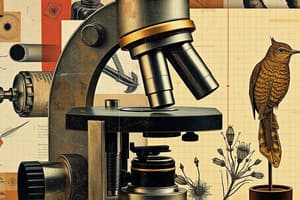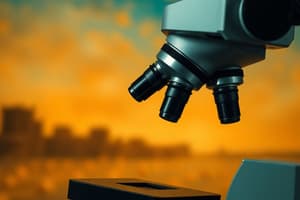Podcast
Questions and Answers
What is the function of the main tube in a compound microscope?
What is the function of the main tube in a compound microscope?
- To collect images from the sample and create real images
- To connect lenses and eyepieces to form the observed image (correct)
- To enlarge the final image before reaching the eyepieces
- To support slides holding study materials
Which component of a compound microscope is responsible for holding study materials during observation?
Which component of a compound microscope is responsible for holding study materials during observation?
- Objective Lens
- Main Tube
- Eyepiece
- Stage (correct)
What is the primary function of the objective lenses in a compound microscope?
What is the primary function of the objective lenses in a compound microscope?
- To connect lenses and eyepieces to form the observed image
- To support and secure slides onto the stage
- To enlarge the image before it reaches the eyes
- To determine how much larger the original object appears on the slide (correct)
What is the purpose of the eyepiece(s) in a compound microscope?
What is the purpose of the eyepiece(s) in a compound microscope?
Which component of a compound microscope determines the different magnification options available?
Which component of a compound microscope determines the different magnification options available?
Why is a compound microscope considered a powerful tool for observing fine structures?
Why is a compound microscope considered a powerful tool for observing fine structures?
What is the function of the focus knobs in a compound microscope?
What is the function of the focus knobs in a compound microscope?
How does the condenser in a compound microscope contribute to image quality?
How does the condenser in a compound microscope contribute to image quality?
Where is the diaphragm typically located in a compound microscope?
Where is the diaphragm typically located in a compound microscope?
Which part of the compound microscope is responsible for regulating contrast and color saturation?
Which part of the compound microscope is responsible for regulating contrast and color saturation?
How does the coarse adjustment knob differ from the fine adjustment knob in a compound microscope?
How does the coarse adjustment knob differ from the fine adjustment knob in a compound microscope?
What role does the iris diaphragm play in a compound microscope?
What role does the iris diaphragm play in a compound microscope?
Flashcards are hidden until you start studying
Study Notes
Exploring the Components of Compound Microscopes
A compound microscope is a powerful tool used by scientists, biologists, and students worldwide for observing minute details in specimens at magnifications well beyond what our naked eyes can perceive. To reveal such fine structures, this microscope employs several components working together in harmony. Let's delve into these vital elements to understand their roles more profoundly.
Main Tube The main tube serves as the central axis along which light travels between other key components like lenses and eyepieces, connecting them to form an image we observe while peering through the eye pieces.
Eyepiece(s) Also known as ocular lens, the eyepiece enlarges the final image produced by the main tube further before it reaches your eyes. Typically, a compound microscope comes with two or three interchangeable eyepieces offering different magnification options.
Objective Lens(es) Situated closest to the sample, objective lenses collect images from the sample and create real, intermediate images within the microscope body. Most commonly found in various powers such as 1x, 4x, 10x, 40x, and 100x, they determine how much larger the original object appears on the slide when viewed through the eyepiece.
Stage This flat platform supports slides holding study materials during observation under the microscope. A stage clamp helps secure slides firmly onto the stage so they don't move around while focusing.
Focus Knobs Two focus knobs, one coarse adjustment knob located near the eyepiece and another fine adjustment knob closer to the objective lens, help you bring the image into sharp focus. These knobs control the movement of the objective lens relative to the stage.
Condenser Much like a projector uses a condenser to concentrate light onto the screen, a compound microscope utilizes its condenser to direct light towards the specimen and intensify illumination without diffusing the light too much. The condenser also helps regulate contrast and color saturation via additional controls placed below the stage.
Diaphragm Sometimes referred to as the iris diaphragm, this component regulates the amount of light entering the microscope by controlling slit size. It is typically situated near the base of the condenser, allowing users to adjust brightness levels according to their needs.
These essential components work harmoniously to deliver unparalleled observations and insights into the tiny world hidden beneath the microscope's eyepiece. Whether studying biological organisms or examining intricate mechanical designs, understanding the function of each part within a compound microscope will undoubtedly enhance your experience and appreciation for this fascinating field of exploration.
Studying That Suits You
Use AI to generate personalized quizzes and flashcards to suit your learning preferences.




